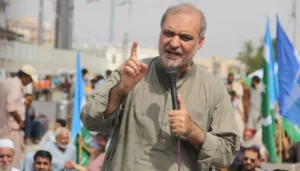Karachi as an Urban Metropolis and the Struggle for the City
by Imaan Azeem Uqaili
As the sixth largest city in the world and the largest city in Pakistan as well as its financial hub, Karachi has often been at the center of political turmoil and sensationalism through media journalism and how it often fails to meet the criteria of perhaps a developed city. Located on the Arabian Sea, its title presents a dichotomous reality in terms of its actual physical state, however, the light of the city continues to emanate in the diversity of the people that inhabit the most populous metropolitan city in Pakistan. The 2016 population for Karachi is estimated to be 16.62 million (World Population Review) and as of now, it is estimated to be around 18 million. The large multiethnic population and the city’s urban landscape, put it at an interesting apex of development in reverse and non-conventional forms of historic and present urban resilience.
Usually, we read about and partake in discussions surrounding urban resilience that denote sustainable cities that involve tangible development, as in the case of Karachi – in this review paper, I attempt to shift this focus from that to the people that occupy these cities and their struggle, resilience and adaptation to tough political, economic and social climates that make global cities such as Karachi more resilient than imaginable through adaptation, activism and initiative.
Through Laurent Gayer’s ethnographic account of Karachi’s population managing violence through its continual transformation and fear in the 1980s and those threads manifesting in the present, I would draw comparisons and contrast how this management of urban political warfare by citizens in cities across Turkey, such as Istanbul in the event of the Gezi Park protests, struggles for environmental justice as an example of successful grassroots mobilization in the Brazilian Amazon, resistance and the politics of dissent between police and drug dealers in urban Argentina, the resistance of non-white people in their struggle for the provision of home buyout programs, manifests in the development and making of resilient urban spaces that have sustained through their struggles.
Karachi as an Urban Metropolis and the Struggle for the City
According to the Economist Intelligence Unit’s Global Livability Report 2017, Karachi is one of the ten least livable cities in the world. The report includes stability, environment and culture, health, infrastructure including public transport and affordable housing and education as its markers for measuring livability. In Karachi: Ordered Disorder and the Struggle for the City, Laurent Gayer mentions a pamphlet distributed to American soldiers in World War II that presented Karachi as the “Paris of the East” and the “cleanest city in all of India”. As of now, around seventy percent of Karachi’s 18 million inhabitants are below the poverty line with the city’s ethnographic description ranging from garbage heaps lining city streets, open sewage lines as commonplace, bumpy roads and pollution with unreliable mass public transport system and, failure to meet the demand for a substantial portion of housing.
Despite the normalizing of terror during the 1980s in Karachi and apparent chaos, social life in Karachi continued with regulatory mechanisms. According to Gayer, four events have reinforced sustainable political strife in the city and leading it to a fragile equilibrium – the emergence of the MQM amid a lack of a political party’s monopoly, MQM’s rule through disruption and spreading of lack of control, rise of coalition politics that led to identity politics with political parties representing distinct ethnic groups and constant state intervention.
Karachi can be seen as a city of migrants from its origin. It has been lamented and turned as a social genre by renowned poets as a specific genre, “sheher-e-ashob” (The city’s misfortune’). As Parveen Shakir wrote,
“Karachi
Ek aisi biswa hai
Jis ke sath
Paharon, maidanon aur sahraon se ane walah
Har size ke batwey ka admi
Rat guzarta hai
Aur subhe uthte hi
Uske dahne rukhsar par
Ek thappar rasid karta hai
Aur dusre gaal ki tawaqoh karte hue
Kam par nikal jata hai
Agli rat ke nashe mein sarshar”
(“Karachi
is a whore,
with whom every eligible man,
descending from the mountains
or emerging from the plains and deserts,
with wallets of different sizes,
spends the night.
In the morning,
slapping her on one cheek,
he expects the other one,
and leaves for work,
drunk in anticipation of the night to come.”)
Parveen Shakir (1952–1994)
The sexualization of Karachi and contrast to that of a prostitute are indicative of the notion that the quality of life for its residents has been far from achieved and Gayer goes on to connect it to Bombay’s similar history and struggle, wherein the ‘two megacities had to cope with the crisis of their cosmopolitan ideal, in the last decades of the twentieth century. This form of a lament to the city was also a means of resistance and denouncement of the army’s intervention in the city in 1992.
The history of the founding of modern Karachi was that of an ‘open city.’ The everyday struggles of Karachi’s residents amid this political strife and ordered disorder, have showed that a large part of its urbanization has been left on its ‘unofficial sector.’ The unofficial sector comprises of any entity besides the government or the establishment. It is this sector that this essay attempts to unpack through the lenses of social and political activism and social mobilization, in Karachi through Gayer’s account to the other global city centers around the world.
Parween Rahman was the late director of Karachi’s most influential postcolonial NGO – the Orangi Pilot Project. She would emphasize a more heuristic distinction is between actors operating in their official and unofficial capacities as a shift from the informal to the unofficial implies that the proper boundary of split in the context of Karachi’s poor urban development and planning is not between state and society or between public and private, but rather as Rehman used to say “even the official is illegal.” This could be seen in the form of illegal buying through bribery as those buying plots from the termed formal sector have to pay bribes to public officials involved in these exchanges.
This is transformative urban resilience and we shall see this now in the context of the Gezi Spirit in Turkey.
Reimagining Resilience through the Gezi Spirit in Turkey
The significance of the Gezi protest in June 2013 due to a conflict over Gezi Park in central Istanbul was a spillover effect of the continuous resistance to Turkey’s aristocratic developmental model and the Justice and Development Party’s (AKP’s) urban policies. The ‘Gezi Spirit’ continued to politicize space through various elements of de-localization, so it had a significant impact on the civil and political landscape of Turkey. In the article, The Work of a Few Trees: Gezi, Politics and Space, there is mention of an email being sent to the activist circles of Istanbul that informed them of the abolition of the park which stood as one of the few green spaces in the city center and the updates surrounding it. The impact of this email can be seen in the testimony that, on that night only, a few activists immediately reached the park and prevented a few trees from being chopped up, ‘forced the construction vehicles to retreat and set up a small resistance encampment to defend the park” (Erensu and Karaman, 2017). The power of words and action that awareness can lead to, such as the meeting of such anti-environment-friendly policies in the case of Gezi Park with increasing resistance can be seen through the actual ceasing of such measures as a result of them. This is active social and political activism and contributing toward urban resilience in transformative and enduring ways.
The spirit of these Gezi Park demonstrations from May 28, 2013 – Aug 20, 2013 continued to politicize space through various elements of de-localization, and it had a significant impact on the civil and political landscape of Turkey. Moreover, the enormous importance that slogans and phrases such as ‘Yasam Alani’ (life space) in the context of this particular incident had and can have is an important part of social and political activism in the struggle for the city and acquiring right to it. We can also see that in the political work of space and its production, how both reinforce each other – the production of space becomes both the cause and stage of the revolt, as seen in the case of Gezi which was both the cause and means of the revolt. The revolt’s high form and energy can be due to the reason that Gezi is in Turkey’s most central open space and that helped mobilize as well as provide channels for massive participation in the (re)production of space and gave a voice to the public. Yasam Alani as a spatial political imaginary became a crucial symbolic notion to unite public demands around urban and rural commons. We can see how a central, historic park within Istanbul became a symbol and means with spillover effects, delocalizing political stakes from the literal space of Gezi to re-localizing them to a variety of settings across the urban and rural continuum and divide. We can see a similar thread of local communities’ resistance countering the negative impacts of sites that serve as a means of infrastructure development, for urban actors often totally neglecting and disregarding communities directly affected by them, in the struggles for environmental justice in the Brazilian Amazon.
Active Citizenship in the Brazilian Amazon
The event of the construction of the Belo Monte Dam in the Brazilian Amazon that Randell and Klein (2021) in their article, “Hydropower Development, Collective Action, and Environmental Justice in the Brazilian Amazon,” analyze is an instance of a successful grassroots mobilization. The exploitative national scaling of development projects such as that of dams with no evidence of local-level benefits is what makes the Brazilian Amazon a site of contemporary internal colonialism, where despite the provision of jobs to outsiders and other people, socially and environmentally, it led to the displacement of at least twenty thousand people with various other negative consequences such as the impact on marine life and threat on livelihoods of farmers, fishers and Indigenous groups.
These farmers and fishers, who were the marginalized people, became active citizens who through recognizing threats, began to engage in resistance, learned to become strategic activists, and through actions, were able to alter their own material conditions which could be seen as a recognition-based form of environmental justice — they took their own improvement and provision of compensation in their own hands, built partnerships with various public and private stakeholders to have a recognition and say. This active citizenship involved people without formal education and prior political experience apart from voting, against nominally powerful actors – the energy company and the federal government, within a context of internal colonialism. The threat of dam construction led to the civic engagement of farmers and fishers, most of whom were neither experienced activists nor highly educated which goes to show the power of collective action and how the participatory process of resistance itself became an education — a powerful example of how collaborative claims-making can lead to actual change and fulfillment of demands, despite not having a solid standing, background or recognition in the society. This incident shows that power is not an attribute, but a relation, in that it is not an entity that people possess but exert. It is not static, but dynamic and reversible. Furthermore, these stakeholders, such as farmers and fishermen who resiliently stood for their environmental justice and right to urban life, should not be seen as politically or educationally deficient, through a deficit-based approach. Through collaborative claims-making, they created a structure of opportunities for/by themselves to reverse an unequal power relationship which led to transformative resistance from political invisibility to civic engagement. Through their collaborative resilience and resistance, they were able to project an increased knowledge of their environmental conditions to relaying scientific evidence of harm that demonstrated the negative effects of the dam on the ecosystem from their experiences of harm. This element of endurance and patience as it comes to activism and resilience can be observed in the Federal Buyout Program in the United States. The resilience in non-whites to attain the provision is commendable, in that it is a much more tedious and long process for them, which is resultant of only their racial identity. ( To be continued)

The author is student in Social Development and Policy at Habib University, Karachi






